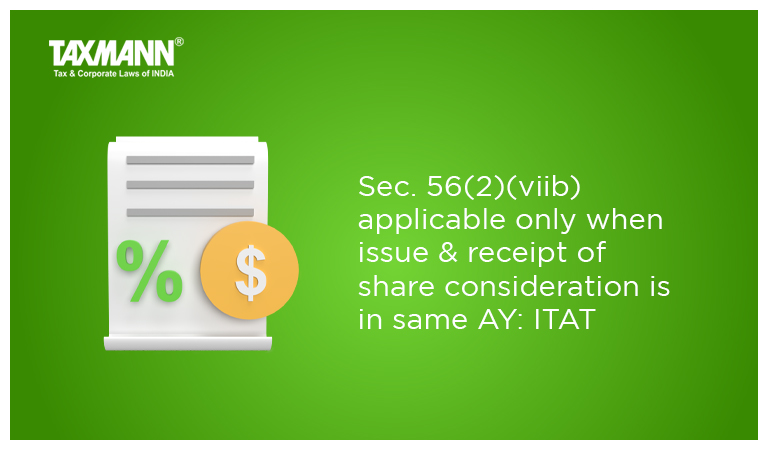Sec. 56(2)(viib) applicable only when issue & receipt of share consideration is in same AY: ITAT
- Blog|News|Income Tax|
- 2 Min Read
- By Taxmann
- |
- Last Updated on 13 September, 2022
Case Details: DCIT v. Rankin Infrastructure (P.) Ltd. - [2022] 142 taxmann.com 37 (Mumbai-Trib.)
Judiciary and Counsel Details
-
- Amarjit Singh, Judicial Member & S. Rifaur Rahman, Accountant Member
- T. Shankar for the Appellant.
- Rajiv Khandelwal for the Respondent.
Facts of the Case
Assessee-company had issued optionally fully convertible debentures (OFCDs) in the assessment year 2013-14. During the year, the assessee converted said OFCDs into non-cumulative preference shares at same price of OFCD.
The Assessing Officer (AO) invoked the provision of section 56(2)(viib) and made additions in respect of consideration received on said conversion to assessee’s income. However, on appeal, the Commissioner (Appeals) was of the view that provision of section 56(2)(viib) would be attracted in year of receipt of consideration and not in year of allotment. Thus, he deleted additions made by the Assessing Officer. Aggrieved-AO filed the instant appeal before the Tribunal.
ITAT Held
The Tribunal held that the assessee had issued optionally fully convertible debentures (OFCDs) and allotted OFCDs on 4-4-2011, 21-7-2011, and 21-3-2012. During this assessment year, the assessee had only converted OFCDs into non-cumulative preference shares at the same price of OFCD.
Therefore, since the assessee had converted the OFCDs into non-cumulative preference share during this assessment year, AO invoked the provisions of section 56(2)(viib) by interpreting that, section 56(2)(viib) does not contemplate receipts of funds but it deals only with issues of shares.
Section 56(2)(viib) is clear that the words used in the section are
“where a company, not being a company in which the public are substantially interested, receives in any previous year…….”.
Therefore, the words used are received.
The “receives” means not the only issue of shares but also receipts of share consideration during the same assessment year. One cannot interpret the law merely based on the issue of shares or from receipt of consideration, it has to be issue of shares and receipt of consideration during the same assessment year.
It was needless to say that issue of shares includes an allotment of shares. Thus, the Commissioner (Appeals) had discussed the issue elaborately in his order and there was no reason to interfere with the findings of the CIT(A).
Disclaimer: The content/information published on the website is only for general information of the user and shall not be construed as legal advice. While the Taxmann has exercised reasonable efforts to ensure the veracity of information/content published, Taxmann shall be under no liability in any manner whatsoever for incorrect information, if any.

Taxmann Publications has a dedicated in-house Research & Editorial Team. This team consists of a team of Chartered Accountants, Company Secretaries, and Lawyers. This team works under the guidance and supervision of editor-in-chief Mr Rakesh Bhargava.
The Research and Editorial Team is responsible for developing reliable and accurate content for the readers. The team follows the six-sigma approach to achieve the benchmark of zero error in its publications and research platforms. The team ensures that the following publication guidelines are thoroughly followed while developing the content:
- The statutory material is obtained only from the authorized and reliable sources
- All the latest developments in the judicial and legislative fields are covered
- Prepare the analytical write-ups on current, controversial, and important issues to help the readers to understand the concept and its implications
- Every content published by Taxmann is complete, accurate and lucid
- All evidence-based statements are supported with proper reference to Section, Circular No., Notification No. or citations
- The golden rules of grammar, style and consistency are thoroughly followed
- Font and size that’s easy to read and remain consistent across all imprint and digital publications are applied








 CA | CS | CMA
CA | CS | CMA


